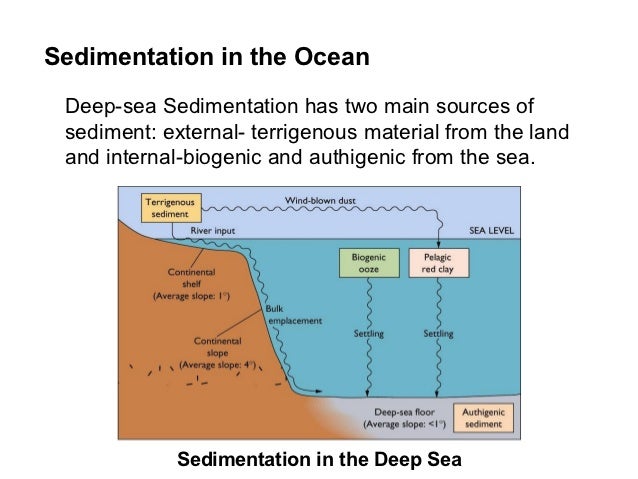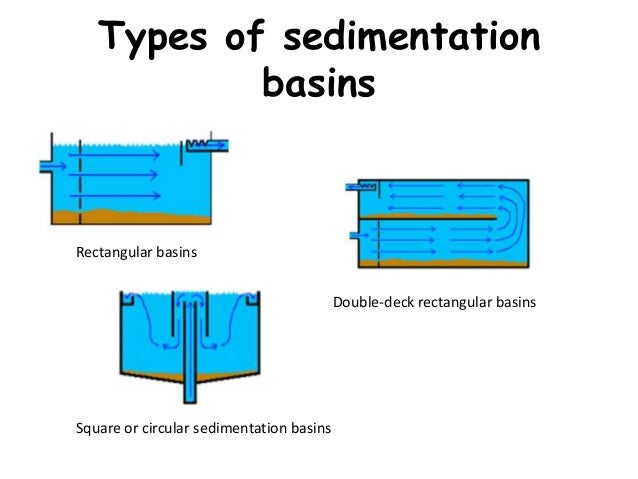Sedimentation
Sedimentation or sedimentation (from Latin sedimentum " dregs " ) is the deposition / settling of particles from liquids or gases under the influence of gravity or centrifugal force. Forms at the bottom a layer of suspended matter, it is called this sediment, sediment or (to exclude confusion with sedimentary rock ) unconsolidated sediment ( loose rock ).
Basics
With sedimentation, the particles deposited layers due to their different sedimentation rates ( Absinkgeschwindigkeiten ) according to their density and size. The particles with the greatest sedimentation are deposited first, thus lie at the bottom. Since the sedimentation rate is essentially determined by the density, different materials can be deposited in layers separately, which can also be used to separate the different substances in a mixture ( see decanting ). If only one material deposited or materials of similar density, store large particles faster and lie down first, while small particles on top. Thus, the greater the density, the faster it drains the fabric to the ground. In foamed material such as eruptive pumice, an inverse grading may occur, then smaller particles have a higher rate of sedimentation and store below, while larger store above.
Natural sediments
Natural sediments can be subdivided according to their origin into three main groups:
- Clastic sediments (transported by water, wind, glaciers, debris flow, etc., and so mechanically shaped particles, such as sand, gravel bar, Sandbar )
- Chemical sediments ( excreted by chemical processes from aqueous solutions by precipitation, for example, carbonates )
- Biogenic sediments ( deposits of organisms or from organisms residues, such as coral reefs )
The site of deposition is another way classification. Here you can fluvial, lacustrine, marine, Aeolian, glacial and pyroclastic sediments diffuse.
Be pre- Led the particulate in the event of a natural sedimentation usually by erosion processes and this mainly by fluvial transport, which is usually a weathering of the parent rock is preceded it. Depending on the distance to the removal site and the flow rate, the particle size distribution of suspended particles in the water to clear differences. The rule here is that the grain size of the particles with the distance and a descending flow velocity decreases, as the largest and heaviest particles ( sediment ) settle first and often the flow is no longer able to stir up these from the river bottom.
Especially in stagnant waters, these suspended particles by gravitational deposition of sediment layers from which the part to determine the age ( stratigraphy ) are used. This is mainly because, in contrast to rivers there is no more flow and therefore can also deposit very small particles. In addition, the sedimentation often shows depending on the climate system, a different pattern over the year, as, for example, settle in the winter with a frozen waters of the finer particles. Thus arise, similar to the annual rings of trees, coarser and finer layers per year, which are called varves. These often include living organisms or their tracks with one, which may develop in the course of fossilization fossils. The formation conditions ( paleoclimate ) of the individual layers are documented in these times, which is why sediments are important climate archives. Particularly marine, shallow marine deposits and seeische have in this respect a high explanatory power, which is why they are also the main objective of climatological research drilling.
While by progressive sedimentation increases the thickness of the sediments, especially the rising pressure in the deeper layers may trigger other geological processes. The diagenesis forms, from the unconsolidated sediments, the sedimentary rocks. A special case in this case represents the snow, which can also be layered and compressed under pressure influence on ice. Does this effect over several years, so this can lead to the formation of a glacier.
Application
In so-called " split systems " this effect is used as the biological preparation by making use of density dependent sedimentation for the separation of particles, such as protein molecules or biological cells. In a laboratory mill, sedimentation is carried out in which the volume of the sediment of a flour - water slurry is a measure of the swellability of the proteins in the flour. In soil science Sedimentationsversuche are used to determine the particle size distribution of a soil.
Distributed in smaller mills the principle of sedimentation is used to purify the resulting vegetable oil at the pressure of trub oil sediments. Here, the squeezed oil is placed in a container in which it can remain a long time (up to several weeks), while the heavier sediments slowly drop by gravity to the bottom. After the sedimentation, the purified oil is slowly removed from the container so that the particles remain in the lowered Sedimentationsbehältnis. Newer vegetable oil sedimentation run continuously. Here, the to be cleaned trub oil flows through a pipe system by successively connected containers. Here, the lees ( sediment) from each set in individual containers, so that after leaving the final container, a high degree of purification is achieved.
Another practical example is the mechanical purification of water in the settling tank of a wastewater treatment plant.
In the production, storage and processing of suspensions such as paints, casting resins, concrete, or even some foods sedimentation is often also a disturbing effect dar.










